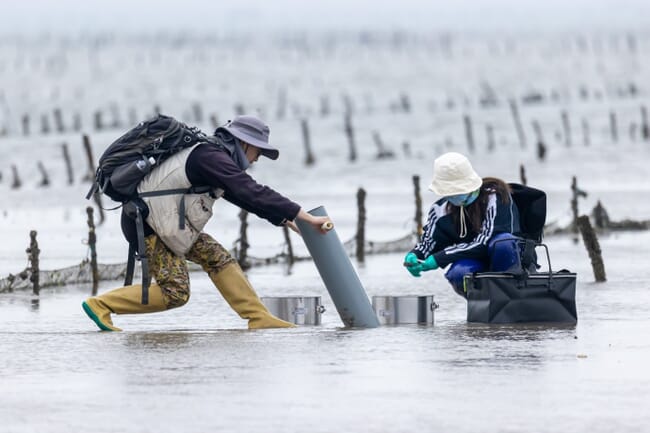
© Royal Netherlands Institute for Sea Research
The study was undertaken by biologist He-Bo Peng and colleagues, who sampled bivalves at 21 sites – from the city of Dongliaodao in the tropical south, to the mudflats of Yalu Jiang, more than 2,000 km further north and ice-covered for several months in winter.
Bivalves account for the majority of Chinese mariculture harvests, at over 14 million tonnes a year, and the researchers note that humans routinely collect the juveniles of commercial species at one location and transport and spread them to intertidal mudflats elsewhere. Because the commercial species are chosen on the basis of their strong adaptability, such species have quickly become the most abundant in some intertidal areas, often reducing the densities of local species.
“At 19 out of these 21 sites, commercially exploited species dominated,” Peng said in a press release. “In the naturally occurring species, we still recognised the natural gradient, with highest diversity in the tropics and lowest diversity in the north. However, the same commercially exploited species were found in all regions, regardless the climatic conditions. Also, the commercial species dominated almost all mudflat communities.”
One of the dominant species nowadays is Potamocorbula laevis.
“At some locations, this bivalve represented 95 percent of the biomass,” said Peng.
However, he added that this is not necessarily due to culturing this bivalve.
“The intensive fishing for shrimps has almost eradicated a natural enemy of the small fragile juveniles of this bivalve. Possibly, this lack of predators has now favored P. laevis,” he explained.
The eradication of the south to north biodiversity gradient and the dominance of commercially exploited bivalve species may be a blessing in disguise for migratory birds along the Chinese coast.
“At sites where there’s a lot of P. laevis now, migratory birds like red and great knots find a lot of food as they refuel during their migrations between Australia and the tundra areas of northeast Russia,” said Peng.
However, the scale of the impact is still a cause for concern.
“But the more general point raised by this study is the immensity of the role of human activities in determining coastline biodiversity. Where once there was a strong climate gradient in biodiversity, aquaculture and fisheries have favoured uniformity now,” he explained.
“This extensive research along more than 18,000 km of Chinese coast builds on the Dutch tradition of studying mudflat ecosystems”, said Theunis Piersma, researcher at the Royal Netherlands Institute of Sea Research (NIOZ) and promotor of PhD student Peng as professor of global flyway ecology at the University of Groningen.
“Sampling programmes like SIBES in the Dutch Wadden Sea taught us the value of widespread and continuous sampling. In this study He-Bo Peng once again shows the value of documenting benthos at very large spatial scales, with sampling strategies developed in the Wadden Sea.”
The full study, Mollusc aquaculture homogenizes intertidal soft-sediment communities along the 18,400 km long coastline of China, has been published in this month’s issue of Diversity and Distributions.




